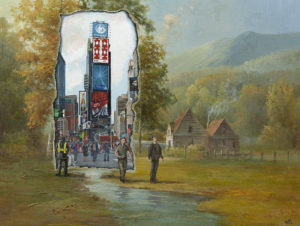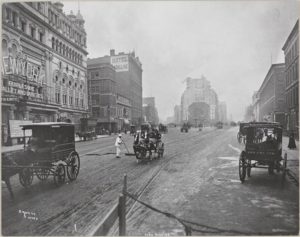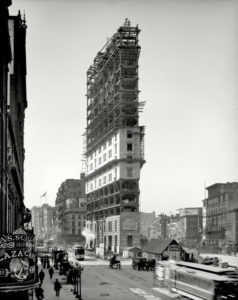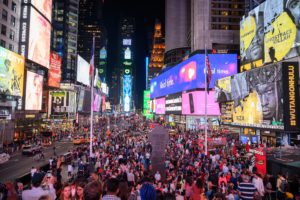I’m bending the rules for this week’s Architecture in Art. We’re not checking out a building per se, but more so exploring one of the most famous spaces in the city and the world – Times Square. While every real New Yorker dreads this area, it is truly the heart of NYC. In fact, it’s the second most visited location in the world, only behind the Las Vegas Strip!
Dave Pollot’s work Bleed II captures a current glimpse of Time Square, along with what it looked like in a not-so-distant past. Times Square has only existed for a bit over a century… and the notion we have of Times Square today is an even newer concept.
Back in the 1700s, this land was filled with nature and had small streams running through it. It belonged to a general of the New York militia who served under George Washington who used it for farming and breeding horses. By the 19th century, it had been acquired by John Jacob Astor. While the Astor name is held in high regard, it might surprise you to know he made his fortune by establishing a monopoly on the fur trade and then getting wrapped up in smuggling opium; he used the proceeds to invest in NYC real estate. Astor made his second fortune selling off his land to hotels and developers as the city grew.
By the end of the 1800s, the area was known as Longacre Square. It was in December of 1880 that Broadway became electrified; the bright lights attracted large, wealthy crowds. But it was also around this time that it was given the nickname Thieves Lair. While theatres began dominating the area, underground businesses like gambling and prostitution followed, and the wealthy theatre patrons made for easy pickpocketing targets.
It wouldn’t be until 1904 that the name was officially changed to Times Square, in honor of The New York Times; they had moved their headquarters to the south side of the main intersection. That same year, electrified advertisements began popping up – the first included Trimble Whiskey and Budweiser. Following WWI, it became a cultural hub as theatres continued to pile in, along with music halls and upscale hotels. That’s when advertising took over with some of the largest billboards in the world.
Through the Great Depression, many theaters closed and were replaced with brothels and saloons; the area had a seedy reputation for decades. By the 60s, it was described as “the worst block in town” – it was filled with sex shops and peep shows, and crime became rampant. To make matters worse, the NYPD was ordered to stay away from the area to avoid corruption scandals that plagued the department at the time.
It wasn’t until the 90s that Times Square was revitalized into what we think of today. Now, it’s one of the world’s most popular tourist destinations, with approximately 50 million visitors annually, and home to the iconic New Year’s Eve Ball Drop.




